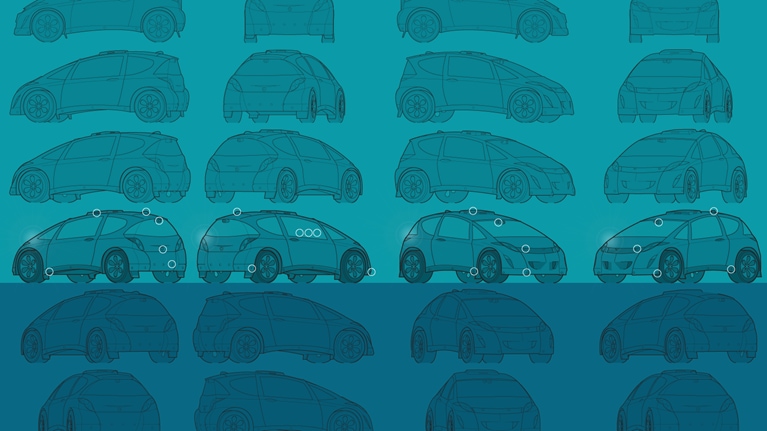Personal mobility could change profoundly in the next two decades. Consumers, who increasingly view mobility as a service, want more choices for traveling between points A and B, including ride hailing, car sharing, and perhaps even self-driving “robo-taxis.” For automakers, the proposed changes could replace the industry’s traditional emphasis on “moving metal” with new schemes to capture greater profits per mile or per trip. The focus may even expand from monetizing new mobility models to monetizing the time consumers spend in vehicles.
Stay current on your favorite topics
Autonomous vehicles (AVs) could play a key role in this transformation. But the industry tends to view the phenomenon mainly through a technology lens, which, while important, only addresses part of the challenge. Industry discussions often focus on autonomous-driving levels, such as the Society of Automotive Engineers’ conditional, high, or full-automation specifications (SAE levels 3, 4, or 5, respectively). However, automakers also need to fill in several other gaping holes to understand autonomous-driving issues fully. That requires an ecosystem approach (for more on broader shifts in the landscape, see sidebar, “Measuring the robo-taxi’s disruptive potential across automotive trends”).
Unlocking the AV ecosystem via use cases
Building a successful AV ecosystem requires four perspectives. The first centers on the technology involved: What can it do now, and how soon will it be able to do more? Regulation comes next: How will it and associated policy-making initiatives create opportunities for deployment? Third, the customers: Who are they, and how willing are they to use the product? For example, from a total-cost-of-ownership (TCO) perspective, will consumers still buy private cars when AV taxis become commonplace, or will they switch to this new mobility option? Fourth, the business case: Is it profitable and sustainable? In other words, will shared robo-taxis disrupt today’s shared-mobility market?
Use cases can also help regulators understand how policies might have to change in different situations. For example, in a “geofenced” area (one where the AV cannot leave the area), a private AV might face different regulations than an L4 robo-taxi. Similarly, an L4 robo-taxi operating in a city may face different regulations than an L4 interstate truck, even though both meet the same L4 readiness standards.
The use case–based framework (Exhibit 1) enables businesses to understand the underlying technology needed, the focus of regulations, the customer, and the impact on future value pools and go-to-market strategies—all elements of an AV ecosystem.

The framework determines the following:
Where the AV operates. Understanding where fleets can operate AVs (for example, on highways or local roads) helps to frame the limits of the technology. These limits will identify the routes available for AV use and the business opportunities they provide for fleets. Likewise, the availability of specific infrastructure, such as the high-speed communications networks (for instance, fifth generation, or 5G) needed for successful over-the-air (OTA) software updates, will help fleets achieve total reliability in each operating environment.
Would you like to learn more about the McKinsey Center for Future Mobility?
Who owns the mobility offering. A perspective on fleet or private ownership can help players identify shifting value pools and determine customer willingness to pay. Perhaps most important, it clarifies who the customer really is.
What the vehicle will transport. People or parcels? Crystalizing an informed understanding of what the vehicle will transport can help businesses determine the best go-to-market strategies. Based on customer differences, robo-taxis could conceivably transport passengers or goods, or both. This raises vehicle-design questions as fleets attempt to achieve maximum utilization levels, for example, transporting people during the day and goods at night in the same vehicle.
After analyzing multiple use cases (Exhibit 2), we decided to focus on three main AV opportunities where the convergence of different elements of the AV ecosystem appear the most promising: robo-taxis, long-haul trucking, and last-mile delivery services. Of these, we felt the robo-taxi use case with high to full automation (Level 4 or above) showed the greatest promise.

The robo-taxi use case: Exploring mobility as a service
By treating mobility as a service instead of a one-off transaction, automotive players could open new revenue pools worth billions, and in the process disrupt both the automotive and mobility business models. For example, a car company might earn only $2,500 on average for each car sold; spread over a 150,000-mile vehicle life span, that works out to about a penny a mile. The mobility-as-a-service model throws that penny-pinching approach out in favor of a more lucrative profit-per-trip focus. This represents a radical change in how the industry looks at profitability. It could signal a complete shift in thinking about the value of a mobility mile and how to capture it. Robo-taxis could recast profit pools and the ownership of “control points,” which are the profitable places that specific players control with hard-to-replicate, high-value offerings. For robo-taxis, control points might include critical technologies such as AV sensors or operating systems, or specific customer touchpoints. These changes will have knock-on effects in other industries such as insurance, airlines, rail, and infrastructure.
The success of robo-taxis will likely change car-ownership and public-transportation dynamics at a fundamental level. By offering lower mobility costs, greater convenience (for example, providing door-to-door service without disruptions), and increased productivity as they free occupants from driving, robo-taxis will change how people think about mobility in urban environments. In fact, the extremely low costs associated with the use of robo-taxis could make it a true game changer whose impact goes beyond current shared-mobility norms. The economics could convince people in large cities to switch entirely to shared mobility. In other words, costs this low could drive a major mobility disruption that today’s shared-mobility solutions can’t match, because they remain too close to private-ownership TCOs.
Robo-taxis will also affect society, boosting mobility options for the elderly, people with disabilities, and others with limited access to transportation, increasing automotive safety, and even reducing the need for urban parking spaces.
Looking at feasibility through 2020
Today, autonomous driving remains in the development stage, relying on humans to take control of the vehicle in the event of danger. Given the current state and existing technology hurdles, we believe robo-taxis will evolve in three stages on their way to full autonomy (Exhibit 3). These stages will have profoundly different profiles when it comes to potential miles traveled, roads covered, and journeys allowed.

After the emergence of the first stage (“Robo-taxi 1.0”), a series of technical improvements will boost capabilities and expand available use cases. That means new night-driving capabilities made possible by better cameras, processing improvements to deliver higher-resolution images, and enhanced training data. Likewise, enabling highway trips will require new data-gathering capabilities, improved artificial intelligence (AI), rule-based algorithms, and more robust sensors. Severe-weather driving will only be possible with better sensor hardware and the capability to gather and process additional data to back up decision making.
Each stage will have unique characteristics:
Robo-taxi 1.0, by 2020 to 2022. Worth approximately 200 billion miles of total travel, Robotaxi 1.0 geofences the vehicle’s operating environment and could become technically feasible in the next five years. Constraints include operating only in clear or mildly inclement weather during the daytime at low speeds, on roads with clear lane lines and curbs, and in light traffic. For example, robo-taxis during this stage could drive you around, say, neighborhoods in Silicon Valley, picking you up from home and taking you to other local places at low speeds, while avoiding highways.
Many of these early experiments won’t have robust business cases, because the companies introducing them primarily want to log the miles of experience they need to guide further robo-taxi development. This testing will probably occur in suburban areas (not in city settings or downtown areas) for two primary reasons. First, the lower traffic volumes mean less complex AV decision making and fewer “edge cases,” which are unusual traffic situations like road construction, cars stopping on the road for loading and unloading, or crowds of people moving in different directions. Second, the typically slower, less congested roads can allow robo-taxis to pull over safely if problems arise, without disrupting other traffic.

The automotive revolution is speeding up
Robo-taxi 2.0, from 2025 to 2027. Now the fun begins, as robo-taxis rack up an incredible 3.5 trillion miles traveled. Stage two gives robo-taxis the freedom to maneuver in dense traffic and downtown areas, and on faster-speed roads and highways. In addition to suburban fares, robo-taxis could pick you up at your apartment and ferry you via highways to the city to work or play, both night and day. However, intracity trips will likely predominate. The ability to drive on highways will enable robo-taxis to accumulate significantly more mileage by commuting between various suburban and urban regions.
Robo-taxi 3.0, by 2030. With roughly 4.9 trillion miles traveled, stage three represents a true emancipation of the technology. It enables a robo-taxi to pick you up from your home in Lincoln Park and drive you into Chicago (or vice versa), negotiating poor, unmapped, or unclear roads as necessary. And it will do so in virtually any weather conditions, including fog, hail, and heavy rain, and on snow- or slush-covered roads—conditions that would tax even highly experienced human drivers.
Whether the ability to travel on highways comes sooner or later in the robo-taxi’s evolution remains the subject of debate. Some argue that it is more straightforward than suburban travel, with relatively constant directions and a minimum of edge cases. Others, however, say the higher speeds and episodic congestion could result in more dangerous accidents when something goes wrong. Whenever it occurs, solving the highway challenge will have the largest impact on the coverage of robo-taxis, opening them up to billions of additional passenger miles.
Robo-taxis could clock miles running errands without passengers. For example, you could conceivably send the AV home to take your kids to school while you work, or have it drop you off at the theatre, automatically find a parking space, pay for it electronically, and then come back to pick you up at the curtain call.
Charting the robo-taxi evolution and cross-industry convergence
A successful robo-taxi ecosystem will depend on the convergence of a wide variety of players that come together to choose the best business models, ecosystem partners, and public and private partnerships. Companies will have to work closely with local governments to establish ground rules and partnerships and to ensure necessary infrastructure is in place. This might include ensuring that adequate high-speed data access is available and that smart traffic lights reliably transmit their status to approaching AVs, or it could entail collaborating with or supplementing public transportation. Other examples involve the creation of new electric-vehicle charging areas, the potential use of high-occupant vehicle lanes, and possible vehicle-to-infrastructure integration. Players also need to understand the impact on congestion and parking-space considerations.
Companies must decide where and how to play in the robo-taxi value chain as vehicle-fleet ownership becomes more commonplace. For some, such as automakers, this change could be difficult, since it involves moving toward a service-based, pay-per-mile business model and away from the classic product-centered pay-per-car approach. Car makers could also see a massive switch in customers as fleets begin to replace consumers as car buyers.
Convergence also raises new safety and security concerns. For example, regulatory bodies need the ability to respond rapidly as technology develops to ensure safety while not impeding progress. Likewise, fleets will require robust cybersecurity measures to block malicious attacks, thus opening new opportunities for companies willing to invest in the right technology, expertise, and infrastructure.
Evolving plays require evolving players
Managing the transition to a robo-taxi world won’t be easy. Many companies need to augment their core capabilities and business models—huge undertakings in a rapidly changing environment, where traditional profit pools and control points can change quickly and unexpectedly. These new pools and control points include the ownership of software components such as those used in AV controls, as well as system and vehicle-level integration capabilities. Examples of the latter include determining who integrates all the vehicle’s different AV systems (hardware and software) and who integrates all the rest of its often-piecemeal electronic systems.
Currently, new players from the technology sector and mobility start-ups are well positioned to take charge of the new robo-taxi control points. However, traditional automotive manufacturers can get back in the game, especially if the industry selects a single industry-wide AV solution, including both software and hardware. Such a decision can spread the risk and the cost of the new technology, accelerate development, ramp-up launch timetables, and easily outscale individual proprietary solutions.
The emergence of the robo-taxi raises challenging questions for all mobility stakeholders. Consumers will likely want to know whether car ownership makes sense anymore, given the 24/7 convenience robo-taxis will offer. Should they trade car payments, maintenance costs, and insurance premiums for shared-mobility subscriptions? Likewise, in the age of ubiquitous robo-taxis, where mobility becomes a commodity, will car ownership acquire unique status and prestige? Automakers probably face the greatest challenge of all, as they attempt to transition to a mobility-as-a-service model. What will that look like, and how long will the “tail” of traditional car-buying activity be? What are the implications of the expected bifurcated transitional market, where car companies produce generic, bare-bones robo-taxis alongside fully appointed private AVs?
Regulators must also explore new policy areas that extend far beyond the car itself to touch insurance, financing, and liability issues. How do they ensure decision uniformity across markets and remain sensitive to innovations that could radically alter safety, security, and privacy considerations? Likewise, cities and municipalities need to become proactive partners with the mobility industry to ensure the smooth integration of AV-related infrastructure.
Can self-driving taxi cabs conquer the world? Clearly, they will have a major impact on the automotive industry, disrupting business models and conditioning consumers to seek alternatives to private car ownership. Robo-taxis could also trigger a huge mobility-as-a-service market—one that enables new companies to participate based on the advanced technology content they can bring into play. If fully realized, robo-taxis have significant potential to change the mobility industry, compelling incumbents and new entrants alike to determine how best to capture profitable and sustainable growth in this unfamiliar environment.


